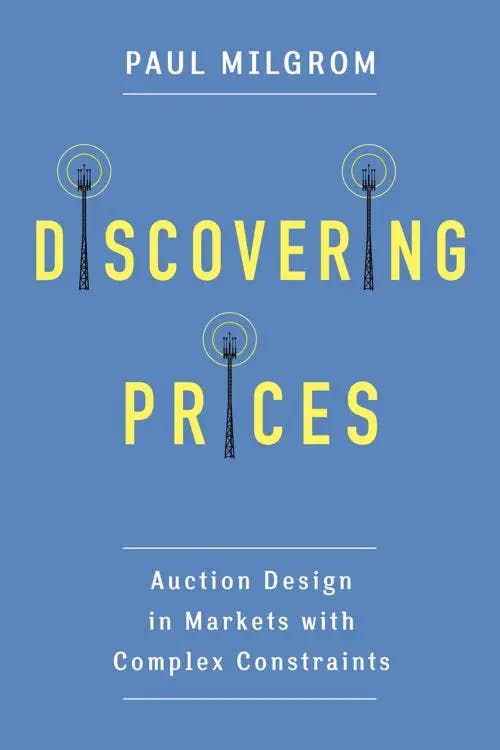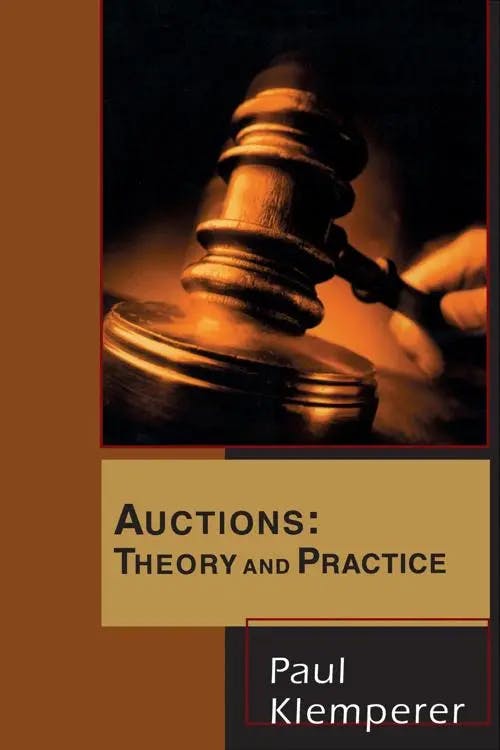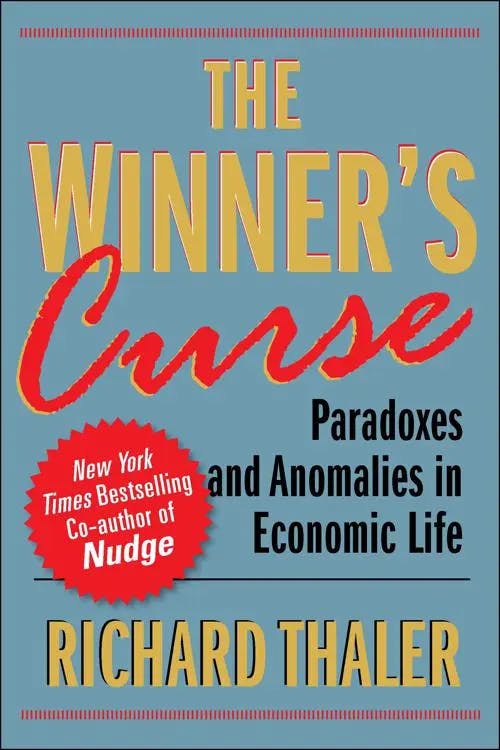What is Auction Theory?
MA, Management Science (University College London)
Date Published: 06.03.2023,
Last Updated: 19.07.2024
Share this article
Defining Auction Theory
Consumers generally purchase goods and services at a price stipulated by the seller. Auctions are an alternative “allocation mechanism”, or purchasing method, where it is consumers themselves that set the price of goods. Indeed, buyers make offers or price bids on items based on their willingness to pay, and auctioneers sell the item to the highest bidder. This sounds like a favourable system for consumers, who could end up paying less for goods based on their purchasing power. But, what about sellers? How do they benefit from this allocation mechanism? Auction theory studies the design of auctions such that their outcome is efficient and optimal for both buyers and sellers in the transaction.
Why is Auction Theory Important?
When most people think of auctions, they often associate it with the sale of paintings, art or antiquities. However, as stated in the book Understanding Auctions, this system has been in place for centuries to sell all types of goods, from temples and monasteries in China, to flowers in the Netherlands, all the way to full Roman empires.
The strangest auction in history is probably the auction of the Roman Empire. The Praetorian Guard decided to sell off the whole of the Roman Empire through auction, after killing the Emperor Pertinax in 193 C.E. The highest bidder was promised that he would be awarded the crown.
Srobonti Chattopadhyay, Rittwik Chatterjee
The strangest auction in history is probably the auction of the Roman Empire. The Praetorian Guard decided to sell off the whole of the Roman Empire through auction, after killing the Emperor Pertinax in 193 C.E. The highest bidder was promised that he would be awarded the crown.
The reason behind the success of this allocation mechanism over time is for its effectiveness in revealing the true value of goods; the buyer is offering what they consider to be a fair price for an item, and the seller accepts and therefore approves of that price. Moreover, the transparency, flexibility, cost-effectiveness and social efficiency of auctions are making them an increasingly popular allocation mechanism in a world of increasingly complex markets. The Nobel Prize winner Paul Milgrom mentioned how auctions address this complexity in his book Discovering Prices. He gave the example of auctions aiding the transition to online markets in the mid-1990’s with the dotcom boom.
This period saw the introduction of the first Internet Web browser, which provided consumers easy access to the World Wide Web and, soon after, to vast volumes of Web-based commerce. Online auctions like eBay, online stores and marketplaces like Amazon, and instantaneous advertising auctions like those run by Google emerged, and automation required that these markets operate with formal rules.
Paul Milgrom
This period saw the introduction of the first Internet Web browser, which provided consumers easy access to the World Wide Web and, soon after, to vast volumes of Web-based commerce. Online auctions like eBay, online stores and marketplaces like Amazon, and instantaneous advertising auctions like those run by Google emerged, and automation required that these markets operate with formal rules.
This surging popularity of auctions as a way of trading goods in highly complex markets makes the study of auction theory of vital importance to understand how these can be best designed to ensure they continue to be the most efficient, transparent and cost-effective allocation mechanism.
How do Different Types of Auctions Work?
Different types of auctions exist for different transactional contexts. For example, a bouquet of tulips should be sold to consumers quicker than a painting should. This is because flowers die out, and paintings don’t. Therefore, one type of auction will be more appropriate to sell the flowers, and another one to sell the painting. Essentially, the inherent characteristics of the items on sale call for different types of auctions, which differ based on the rules enforced during the auctioneering process.
Auction types may be classified in many different ways. For instance, auctions may be sealed (i.e. bids are privately submitted in a sealed envelope) or open (i.e. bids are publicly yelled out or published online) formats. They may also be of private or common value, or happen in sequential or single stage form. Whatever the case may be, the Canadian-American professor of economics and Nobel Laureate, William Vickrey, made a distinction between four different types of auctions, which were classified based on (i) the order in which buyers’ bids are announced and accepted, and (ii) the price paid by the winning bidder. The four different types of auctions are explained below, following this criteria.
- English ascending auction. The auctioneer opens the auction showing the item on sale and announcing a reserve price. This is the lowest price he is willing to accept for an item, which can be zero. Bidders who accept that price and decide to stay in the auction will openly make bids greater than the reserve price in an ascending order. The highest bidder at any point in time is considered to have the standing bid, which can only be displaced by a higher bid from a competing buyer. When there are no new bids greater than the standing bid, the auction ends and the item is sold to the highest bidder at the price equal to the second highest bid. This auction is typically used to sell art, antiquities, used cars or wine.
- Dutch descending auction. The auctioneer opens the auction showing the item on sale. Bidders silently consider what their highest bid for the item would be. The auctioneer then openly calls out the starting price, which should be so high that no bidder would accept it. The auctioneer slowly decreases this starting price by a set amount, in a descending order. For example, if the starting price was $50, the auctioneer might offer the next price at $45. Once one of the bidders feels comfortable paying the standing price offered by the auctioneer, the bidder will bid on the item. This immediately ends the auction, and the item is sold to the highest bidder at the price equal to their bid. This auction type is typically used to sell perishable goods that need to be sold quickly including flowers, tobacco or fresh produce.
- First price sealed-bid auction. Unlike the English and Dutch auctions, in sealed bid auctions, also known as blind auctions, bidders do not know what other buyers are bidding for an item. The auctioneer opens the auction showing the item on sale and announcing a reserve price, which can be zero. All bidders simultaneously submit sealed bids (e.g., in an envelope) so that no bidder knows the bid of any other participant. The highest bidder pays the price equal to their bid. This auction type is typically used to sell real estate and securities.
- Second price sealed-bid auction. The auctioneer opens the auction showing the item on sale and announcing a reserve price, which can be zero. All bidders simultaneously submit sealed bids and the highest bidder pays the price equal to the second highest bid. This auction type is typically used to sell goods on online platforms such as eBay or Setdart.
Notice that in the Dutch and first-price sealed bid auctions, the winning bidder pays a price for the good equal to the highest bid. However, in the English and second-price sealed bid auction, the winning bidder pays the second highest bid for the item. Logically, it would make sense that auctioneers preferred putting their items on sale under the Dutch or first-price sealed bid auctions because the highest bid becomes the selling price, yielding arguably greater revenue for the seller. However, as explained by Paul Klemperer, author of Auctions: Theory and Practice and Economics professor at Oxford University, there is no preferred auction type because they all yield the same revenue for the seller. Indeed, auctions have the amazing property of following the Revenue Equivalence Theorem (RET) whereby,
subject to some reasonable-sounding conditions, all the standard (and many non-standard) auction mechanisms are equally profitable for the seller, and buyers are also indifferent between all these mechanisms
Paul Klemperer
subject to some reasonable-sounding conditions, all the standard (and many non-standard) auction mechanisms are equally profitable for the seller, and buyers are also indifferent between all these mechanisms
What is Auction Theory Used for in Real Life?
The applications of auctions in real-life are ever increasing. We stumble upon these on a daily basis and in the most unexpected of situations when, for instance, typing a query on a search engine tab such as Google. Every time a Google user types a word or sentence in their search tab, a list of websites will appear for the user to click on. This seems simple and rather familiar, but a lot more is going on behind the scenes. An auction is the mechanism that dictates the order in which these websites appear on the users’ device. More specifically, a second-price sealed bid auction. These auctions take place in Google’s online portal called Google Ads, where firms whose product or service is relevant to a user’s search will compete in an auction to position their product higher up amongst the list of search results, increasing the chances of getting clicked on by the user.
For example, IKEA is famously known for selling furniture. Suppose a Google user types “furniture” on their search tab. All firms selling furniture or similar could take part in the auction. Firms who want to advertise their product will submit bids on Google Ads based on how much they are willing to pay to appear high up in the search results every time a Google user types “furniture”. Say that IKEA’s bid was the highest out of all bidding firms. IKEA would be positioned first in the page results and would pay GoogleAds a price known as the cost-per-click for every time a user clicks on IKEA’s website as a result of the auction. Other factors such as how relevant a product is to a user’s search will be taken into account when dictating a firms’ positioning in the page rank. However, it is auctions that essentially determine how internet users focus their attention.
Moreover, property hunting may also be looked at through the lenses of auction theory. When making an offer for a flat or home, you’re actually taking part in a first-price sealed bid auction. On the one hand, the property hunters act as the bidders, and on the other, the landlord or agency as the auctioneer. It is not rare to get an offer rejected even if it was above the landlord’s asking price. Even though most of the time this means that someone else was willing to pay more for the same flat, other times some undisclosed criteria and rules play into the transaction process. It is for this reason that auction theory exists; to ensure that the transactions are standalone effective, removing anyone’s need of gaming the system.
Other examples where auction theory is proven critical is in stock exchange markets, where firms around the world can buy and sell financial assets including bonds, stocks and securities. These stock markets, such as the one in New York (the NYSE), operate under a special type of auction called a double auction. A slight malfunctioning in the market’s mechanism could dwindle the population’s confidence in financial institutions, and lead to unforeseen consequences including worldly recessions and crises. It is for this reason that auction theory must meticulously dictate, ground and overlook the interactions in these markets, to avoid any unintended effects.
What are the Advantages and Limitations of Auction Theory?
The fact that unique sets of rules exist for the different types of auctions may suggest that bidders should play differently depending on the auction format they are facing. However, what makes auction theory dynamic is the fact that all auctions are designed to encourage a single optimal bidding strategy. That is, auction theory naturally lures bidders into offering their true valuation for a good, regardless of the auction type. This strategy not only yields efficiency in the market, but it is simple and intuitive for participating bidders. Whenever faced with any auction format, bidders who are considering how much they should bid for a good should straightforwardly trust their instincts and answer the question: “How much would I pay for this?”.
Apart from the characteristic honesty of auction transactions, these are well-known for the entertainment and excitement of the auctioneering experience, as well as the speed with which goods are sold. They are a rewarding experience for participants who may access rare finds and unique collector’s items. However, as explained in the book Understanding Auctions, the reach of auction theory and people’s general knowledge on the topic is rather limited for it is often thought to be a field of study with narrow applications.
Some people still see auction theory as a rather specialised field, distinct from the main body of economic theory, and as an endeavour for management scientists and operations researchers rather than as a part of mainstream economics.
Srobonti Chattopadhyay, Rittwik Chatterjee
Some people still see auction theory as a rather specialised field, distinct from the main body of economic theory, and as an endeavour for management scientists and operations researchers rather than as a part of mainstream economics.
This misconception and a general unawareness around auction theory will lead to frustrations and collapses in our daily lives. For instance, firms that underestimate the importance of having an auction theory expert as part of their team may find that their marketing investments on Google Ads are not efficiently bringing new consumers to their offering.
Equally, property hunters who are unaware of the fact that auctions make up the backbone of real estate selling processes may end up bidding more than they can afford for a property, drowning themselves in debt. This phenomenon has a name, and it is referred to as the Winner’s Curse. Richard H. Thaler, author of the book The Winner’s Curse: Paradoxes and Anomalies of Economic Life explains how the Winner’s Curse operates under different scenarios, where an auction winner who has overpaid for a good, quickly becomes the loser of the auction.
Winners at auctions are often the real losers—they pay too much and suffer “the winner’s curse —why gamblers bet on long shots at the end of a losing day, why shoppers will save on one appliance only to pass up the identical savings on another, and why sports fans who wouldn’t pay more than $200 for a Super Bowl ticket wouldn’t sell one they own for less than $400.
Richard H. Thaler
Winners at auctions are often the real losers—they pay too much and suffer “the winner’s curse —why gamblers bet on long shots at the end of a losing day, why shoppers will save on one appliance only to pass up the identical savings on another, and why sports fans who wouldn’t pay more than $200 for a Super Bowl ticket wouldn’t sell one they own for less than $400.
Closing Thoughts
Overall, auctions are becoming an increasingly popular allocation mechanism. This is because auctions follow a simple, intuitive distribution mechanism which can be used and applied in the most complex of markets and industries. For this reason, the future of auction theory is bright, with more and more people focusing their attention on this field of study to ensure no player in auction transactions games the system.
Further Auction Theory Resources & Reading on Perlego
To read more about real life examples of auction theory usage, Who Gets What - And Why by Alvin Roth
To read more about Google AdWords, Building for Everyone by Annie Jean-Baptiste
To read more about the Winner’s Curse, Common Value Auctions and the Winner’s Curse by John H. Kagel, Dan Levin
To read more about Auctions in Charities, The Big Book of Benefit Auctions by Jay R. Fiske, Corinne A. Fiske
Bibliography
Chattopadhyay, Srobonti, and Rittwik Chatterjee (2019). Understanding Auctions. 1st edition. Taylor and Francis. Available at: https://www.perlego.com/book/1493269/understanding-auctions-pdf
Milgrom, Paul. (2017). Discovering Prices. Columbia University Press. https://www.perlego.com/book/773932/discovering-prices-auction-design-in-markets-with-complex-constraints-pdf
Klemperer, P. (2018) Auctions. Princeton University Press. Available at: https://www.perlego.com/book/737873/auctions-theory-and-practice-pdf
Osborn, D. and Amuchastegui, A. (2020) Bidding to Buy. BiggerPockets Publishing. Available at: https://www.perlego.com/book/1637519/bidding-to-buy-a-stepbystep-guide-to-investing-in-real-estate-foreclosures-pdf
Thaler, R. (2012) The Winner’s Curse. Free Press. Available at: https://www.perlego.com/book/782393/the-winners-curse-paradoxes-and-anomalies-of-economic-life-pdf
MA, Management Science (University College London)
Inés Luque has a Masters degree in Management Science from University College London. During high school, she developed a strong interest in Economics, leading her to win the national Economics prize in her country of nationality, Spain. Her expertise is in the areas of microeconomics, game theory and design of incentives. Inés is passionate about the publishing industry and is currently working in the consulting department of the Financial Times in London.




